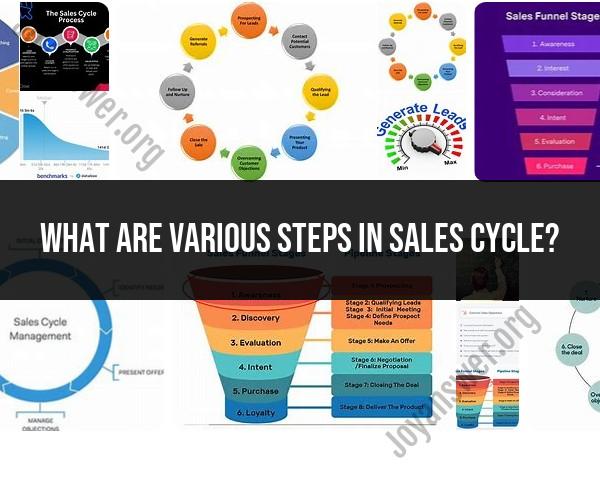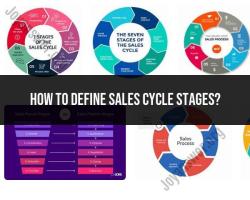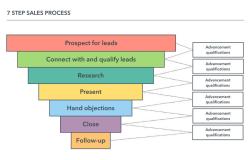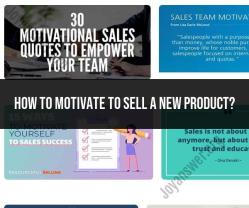What are various steps in sales cycle?
The sales cycle refers to the series of steps or stages that a salesperson or sales team goes through to acquire new customers or clients and close deals. While the specific steps may vary depending on the industry, product or service, and sales process, the sales cycle typically includes the following essential steps:
Prospecting: This stage involves identifying potential customers or leads who may be interested in the product or service being offered. Prospects can be found through various channels, including cold calling, networking, referrals, and online research.
Qualification: Once leads have been identified, they need to be qualified to determine their suitability as potential customers. Qualification involves assessing factors such as their needs, budget, timeline, decision-making authority, and fit with the product or service being offered.
Needs Assessment: In this stage, the salesperson engages with the prospect to understand their specific needs, challenges, and objectives. Through active listening and asking probing questions, the salesperson gathers information to tailor their solution to the prospect's requirements.
Presentation and Demonstration: The salesperson presents the product or service to the prospect, highlighting its features, benefits, and value proposition. Depending on the nature of the offering, this may involve product demonstrations, software walkthroughs, or visual presentations.
Objection Handling: Prospects may raise objections or concerns during the sales process. The salesperson addresses these objections by providing additional information, addressing misconceptions, or offering solutions to alleviate concerns and build trust.
Closing: Closing is the stage where the salesperson asks for the prospect's commitment to move forward with the purchase. This may involve negotiating terms, discussing pricing, and overcoming any final objections or hesitations.
Follow-Up and Relationship Building: After the sale has been closed, the salesperson follows up with the customer to ensure satisfaction, address any post-sale issues, and nurture the relationship for future opportunities. Building strong customer relationships is essential for fostering loyalty and generating repeat business or referrals.
Renewal or Upsell: For ongoing products or services, the sales cycle may include a renewal or upsell stage where the salesperson works to retain the customer and potentially increase the value of the relationship by offering additional products or upgrades.
Evaluation and Analysis: Throughout the sales cycle, it's important for sales teams to track and analyze their performance, assess the effectiveness of their strategies and tactics, and identify areas for improvement. This feedback loop helps refine the sales process and drive continuous improvement.
By understanding and effectively navigating each stage of the sales cycle, sales professionals can increase their chances of success and drive revenue growth for their organizations.
What are the individual steps involved in the sales cycle process?
The sales cycle process typically involves several key steps, although the specific details and order may vary depending on the industry, product, and sales methodology used. Here's a breakdown of the commonly recognized stages:
1. Prospecting:
- Identify potential customers: This involves researching and identifying individuals or businesses who might be interested in your product or service. This can involve utilizing various methods like market research, referrals, and online lead generation tools.
- Qualify leads: Not all potential customers are equally suitable. Evaluating leads based on their needs, budget, and decision-making authority helps prioritize your efforts and focus on those with the highest potential for conversion.
2. Pre-Approach and Preparation:
- Research the prospect: Once a qualified lead is identified, gather information about their specific needs, challenges, and buying habits. This helps tailor your approach and presentation to resonate effectively.
- Plan your presentation: Develop a compelling sales pitch that highlights your product or service's value proposition and how it addresses the prospect's specific needs and challenges. Practice your presentation to ensure clear and confident delivery.
3. Approach and Presentation:
- Make contact: Establish initial contact with the prospect through your chosen method, such as a phone call, email, or in-person meeting.
- Build rapport: Begin by building a positive relationship with the prospect. This involves actively listening to their needs, concerns, and priorities, demonstrating genuine interest and establishing trust.
- Present your solution: Clearly articulate how your product or service addresses the prospect's specific needs and challenges. Highlight its key features and benefits, focusing on how it can provide value and contribute to their success.
4. Handling Objections:
- Address concerns: Prospects often have questions or concerns about your product or service. Be prepared to address these objections clearly and confidently, providing solutions or clarifications that address their specific points.
5. Negotiating and Closing:
- Negotiate terms: If applicable, discuss pricing, contracts, and other terms of the sale. Be prepared to present competitive offers and negotiate win-win solutions that benefit both parties.
- Close the sale: Guide the prospect towards a decision by summarizing the key benefits and offering a clear call to action, encouraging them to purchase your product or service.
6. Follow-Up:
- Maintain communication: Even after a sale is closed, it's crucial to maintain communication with the customer. This can involve providing ongoing support, addressing any questions or concerns, and potentially exploring opportunities for upselling or cross-selling related products or services.
Remember, the sales cycle is an iterative process. You might need to revisit and refine certain steps throughout your interactions with a prospect, adapting your approach based on their specific needs and feedback.







